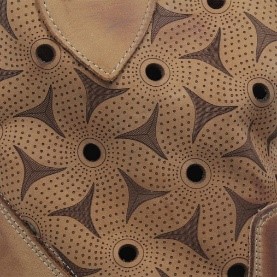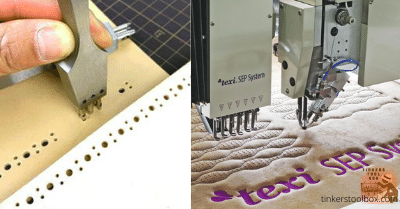Laser Perforation vs. Manual Perforation: A Comparison in Making Leather Shoes
Different Between Laser Perforation and Manual Perforation
Love breathable leather shoes? Those perforated leather holes are your foot’s AC system!
Here’s how they’re made: Laser perforation uses robot precision to punch 500+ holes/minute with razor-sharp patterns (zero crushed edges!), perfect for intricate brogue designs. Manual perforation brings artisan charm—hand-punched holes with organic spacing, ideal for heritage brands craving unique character.
Choosing? Go laser for complex art on dress shoes , pick handcrafted for thick leather boots with soul
Laser Perforation
Laser perforation is a modern method of perforating leather that involves the use of a laser machine to create small holes in the leather. The leather laser engraver is programmed to create holes of a specific size and pattern, which can be customized to meet the specific needs of the shoe manufacturer. Laser perforation has several advantages over manual perforation:

• Precision
Laser perforation allows for a high degree of precision and accuracy in creating the perforations. The laser machine can create holes of a consistent size and shape, which can improve the overall quality of the shoe.
• Speed
Leather perforating is a much faster method than manual perforation. The laser machine can create hundreds of holes in a matter of seconds, whereas manual perforation can take several minutes to create the same number of holes.
• Consistency
Because the laser machine is programmed to create holes of a specific size and pattern, the resulting perforations are consistent throughout the leather. This can improve the overall appearance of the shoe and make it look more professional.
• Reduced Waste
Leather perforating creates less waste than manual perforation. Because the laser machine is precise, it can create the desired number of perforations without creating excess holes or damaging the leather.
Manual Perforation
Manual perforation is a traditional method of perforating leather that involves the use of a hand-held tool to create small holes in the leather. The tool can be a punch or an awl, and the perforations can be created in a variety of patterns and sizes. Manual perforation has several advantages over laser perforation:

• Customization
Manual perforation allows for a high degree of customization. The shoemaker can create perforations in any pattern or size they desire, which can add a unique touch to the shoe.
• Control
Manual perforation allows the shoemaker to have greater control over the process. They can adjust the pressure and angle of the tool to create the desired size and shape of the perforations.
• Versatility
Manual perforation can be done on a variety of materials, including leather, canvas, and synthetic fabrics. This makes it a versatile method that can be used for a wide range of shoe styles.
• Cost-effective
Manual perforation is a cost-effective method, as it does not require expensive machinery or equipment. This makes it an ideal method for smaller shoemakers who may not have the resources to invest in a laser machine.
In Conclusion
Both laser perforation and manual perforation have their advantages and disadvantages in making leather shoes. Laser perforation is a modern and precise method that allows for speed and consistency, while manual perforation is a traditional and versatile method that allows for customization and control. Ultimately, the choice of which method to use will depend on the specific needs of the shoe manufacturer and the desired outcome of the final product.
Video Display | Glance for leather laser perforated design
Recommended Leather Laser cutter machine
Any questions about the operation of Leather Laser Cutter?
Post time: Mar-21-2023



